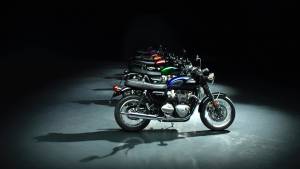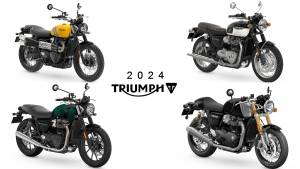Comparo: Ducati Scrambler vs Triumph Bonneville in Ladakh
There is a certain serenity about the mountains. I don't know what it is. It might be the fresh mountain air. It might be the sight of snow covered peaks. It might even be those crystal clear waters that I can see flowing down the valley. Whatever it is, the mountains have always helped me clear my mind. And right now, as I sit with my feet dangling off a rock and watch the mountains, river and clear blue sky, it feels like a perfect place to reflect on the past week.
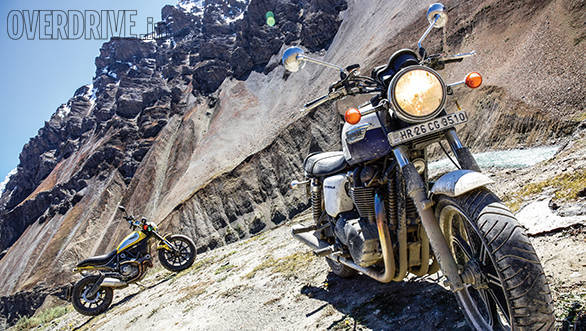
It has been hectic and it started with Rohit and me battling rain as we rode towards Srinagar astride the Ducati Scrambler and the Triumph Bonneville. Both the motorcycles are the most affordable models from their respective manufacturers ,with the Scrambler retailing for Rs 8.07 lakh and the Bonneville for Rs 7.26 lakh (both on-road, Mumbai). They are both retro-styled motorcycles that appeal to the kind of person who has an affinity towards skinny jeans, `2,000 haircuts, thick-rimmed glasses and beards. They are also excellent gateway drugs to cut your teeth on as you start the climb towards larger capacity motorcycles.
But like all big bikes in our country, these motorcycles too are expected to perform well on the odd road trip now and then. And for this, they have to excel at several aspects which includes their suitability to being ridden on highways like the one we were on.
The highway from Delhi to Srinagar is mostly arrow straight roads that take you through Chandigarh and Jammu, after which the roads become curvy and start climbing. Both the Ducati and the Triumph are motorcycles that are happy to cruise at 100+kmph. They are only limited by the lack of wind protection. The difference between the two is that while the Bonneville is happiest cruising at 120kmph, the Ducati likes to push it a step beyond that and sit at 140kmph. This highlights the inherent, more relaxed nature of the British twin something the Bonneville is inspired by. It is not a motorcycle that wants to go flat out all the time. Its character is of a more relaxed, mature motorcycle that is capable of high speeds, but is best experienced at moderate cruising speeds. Even when we tested the motorcycles for top speed, the calmer nature of the Bonnie shone through. Where the Scrambler has seen speeds close to 200kmph, the Bonnie maxed out at 182kmph.
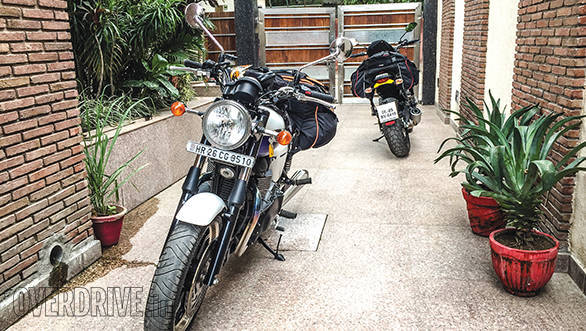
The difference in the motors of both the bikes is primarily in the kind of power and torque they make and in the layout of the cylinders. The Triumph's 865cc, parallel twin makes 68PS and 68Nm while the Ducati's 803cc, L-twin makes 75PS and 68Nm. So, the Ducati makes around 7PS more than the Bonneville despite the 62cc advantage. This is especially evident in the way it pulls away under hard acceleration. When we tested them, the Scrambler clocked 4.9 seconds to 100kmph, while the Bonneville clocked 5.3 seconds. Even when pulling overtakes on the highway, the Scrambler gains speed with much more urgency than the Bonneville.
This holds true even for drive out of corners, which are aplenty once you cross Jammu and start climbing. The roads become nice and wide with freshly laid tarmac. They are three-laned highways that twist around the hills and you can do some impressive speeds and corner the motorcycles to your heart's content.
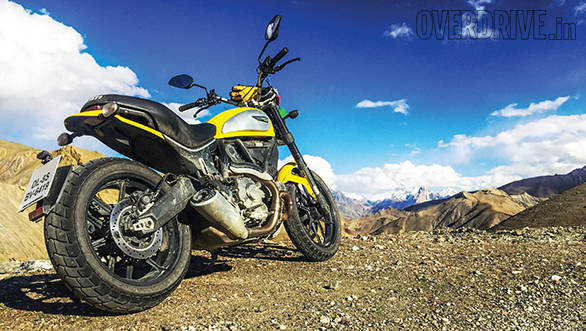 The roads to Leh aren't as much of a challenge as they once were. Nevertheless, there are some stretches where the roads (or lack of them) and the weather can make for a terrible combination
The roads to Leh aren't as much of a challenge as they once were. Nevertheless, there are some stretches where the roads (or lack of them) and the weather can make for a terrible combination
You would think that the Pirelli MT06s that the Scrambler comes shod with wouldn't be the greatest tyres to attack corners with. The big block tyres look more suited to off-road terrain than tarmac. But the moment you start throwing the Scrambler into corners, you realise that they offer phenomenal amounts of grip. The Scrambler uses 41mm, upside down Kayaba forks up front with a single Kayaba shock at the rear. The setup is a lot stiffer than the Bonneville and this gives the motorcycle a lot of confidence in corners. It is quick steering and doesn't get unsettled even if the surface is a bit bumpy. The Bonnie on the other hand uses a conventional 41mm Kayaba fork and twin shocks at the back. While the suspension systems on both bikes are made by Kayaba, they are completely different in character. Now we've always said that the Bonnie itself was a stiffly sprung motorcycle. So the Scrambler being even stiffer does mean that it loses out on a bit of ride quality. But the loss translates into a more direct handling package. Where the Bonnie is all calm and composed no matter what you ask of its chassis, the Scrambler has an urgency to respond to your inputs that makes the bike feel a lot more hyper. What this means is that an aggressive rider like me would like the way the Scrambler responds to inputs. The Bonnie will be appreciated by a more mature rider who likes being smooth with his riding and doesn't slam his motorcycle into corners.
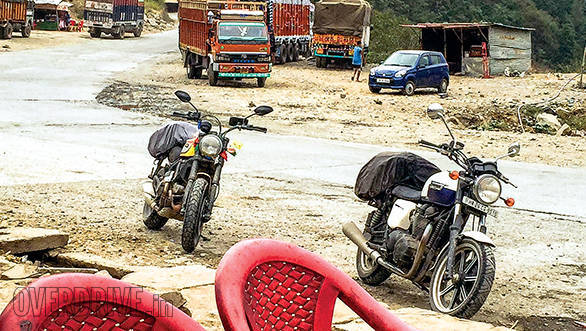
What does disappoint in the Bonnie, though, are the brakes. The single 310mm rotor with the Nissin calliper isn't all that great when it comes to stopping power. It is adequate, but when you consider just how good the Ducati's 330mm rotor with the Brembo calliper is, the Triumph seems only adequate. Add to the fact that the Triumph doesn't get ABS and there is less confidence in the motorcycle's ability to come to a stop quickly. In an age where even small capacity motorcycles have started getting ABS, this seems like a very crucial omission by Triumph.
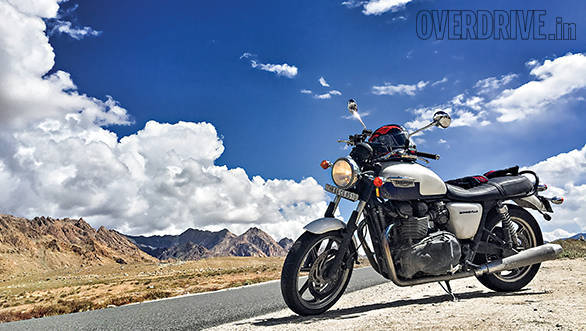
If you're doing a reasonably relaxed speed that is neither too fast nor slow, both bikes are quite comfortable to ride long distances. The seats are wide enough and the foam isn't too soft to be uncomfortable. There is enough space to be comfortable despite having a ViaTerra Claw strapped to the back of the bikes and tank bags on the, err, tanks. However, when you start riding on rough roads and dirt, the luggage can get a bit irksome, a fact that became evident once we crossed Srinagar and started the ascent to Zoji La.
The roads just before and after Zoji La are always in bad shape. When we arrived, though, they were in the most reasonable state that we had seen in years. There was no rain and we didn't have sheets of rock falling on our heads. And best of all, there was no traffic. Those familiar with Zoji La will tell you how it can take a really long time to cross it. This time though, we did it in all of 45 minutes. But once past the pass, the roads got really terrible. The motorcycles though, soldiered on. Aside from testing our physical endurance, the off-road stretches also gave us a chance to evaluate how good the bikes were over the rough stuff.
Fundamentally, the Bonneville has a flaw - its low ground clearance. Initially we were sure that the Scrambler with its high ground clearance and the optional sump guard installed would run circles around the Bonnie. But we soon realised that the Bonnie is not exactly helpless in this battle. While the high clearance in the Scrambler does help it a great deal, it has a great flaw. Since the sump guard is mounted straight on the engine it will only protect the sump from small stones being flung at it and minor impacts. Major impacts would cause it to flex and hit the sump. We didn't experience such damage, but it isn't impossible. The Bonnie on the other hand uses a twin cradle frame. We noticed that most impacts to the undercarriage go straight to the frame rather than the engine. So in terms of actual engine protection, both bikes are, surprisingly, evenly matched.
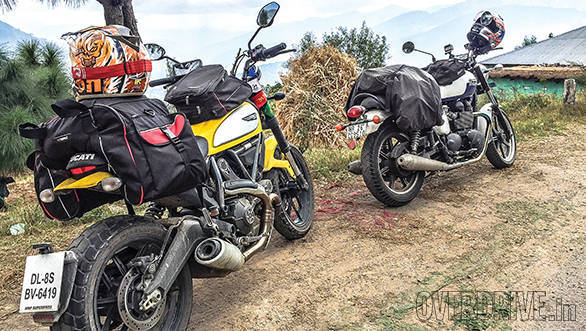 For pretentious, hipster motorcycles, both the Bonnie and Scrambler tackled the rough mountain terrain really well
For pretentious, hipster motorcycles, both the Bonnie and Scrambler tackled the rough mountain terrain really well
But where I found the Scrambler really pulling away from the Bonnie, no surprise, was in actual off-road performance. While we didn't get too adventurous on our way up, we did manage to let the bikes stretch their legs on the return trip. On the way up, the luggage prevented Rohit and me from moving around on the bike too much. This meant that our off-road manoeuvres went only as far as standing up on the pegs. But on the return leg, Rishaad (who joined us in Leh and managed to shove Rohit into the backup car) and I had no luggage on and hence lots of space on the motorcycles. This meant we could now shift our weights around and kick ourselves up whenever we lost the front end.
We noticed that the Scrambler appreciates being ridden like a dirt-bike. When you get really aggressive with your inputs and start throwing it around, the bike starts responding beautifully. At slow speeds, the stiff suspension is quite a pain in the ass. There is no middle ground with this motorcycle on dirt. You have to either be really slow or be going quick enough to make sure the uneven surface doesn't bother you. But it is when you start caning it that the motorcycle starts to work. The suspension has more travel (150mm front and rear) and the Pirelli tyres work so much better than the Triumph's Metzelers in the dirt. The extra power helps too. Especially with that responsive throttle, getting power down to the wheels to get you out of shifty surfaces is a breeze. It will also gleefully let you hang your tail out when you want and handles jumps with a lot more confidence than the Bonnie.
The Bonnie, never designed to off-road, on the other hand is like a tank. It goes slow and steady and swallows up everything in its way. The soft suspension is vastly more comfortable at slow and medium speeds and won't have you complaining of aching arms as much as the Scrambler. The tyres held up pretty well during our ride. We were really impressed that neither bike caught a puncture all the way. Also, the Triumph didn't feel all that happy being thrown around like the Ducati. It wanted to go slow and steady more mature, as we said before. Which is not necessarily a bad thing because it gives you a lot of extra time to take in the fantastic scenery in Ladakh.
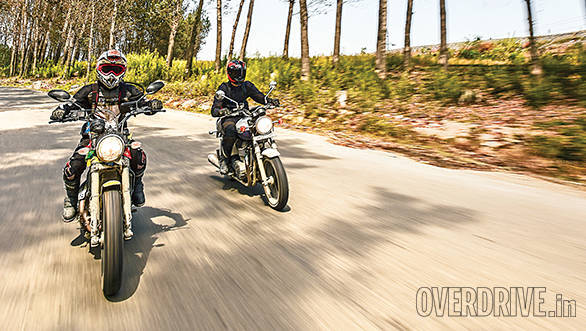
Ergonomics wise, both bikes aren't bad. The Scrambler though ticks two very crucial boxes for me. When compared to the Bonnie, it has a taller and wider handlebar. I don't care for the taller bit all that much since it makes the bike feel like a Harley. But being wider does help in giving you more leverage when riding it rough. The Bonnie in comparison feels exactly like a British twin.
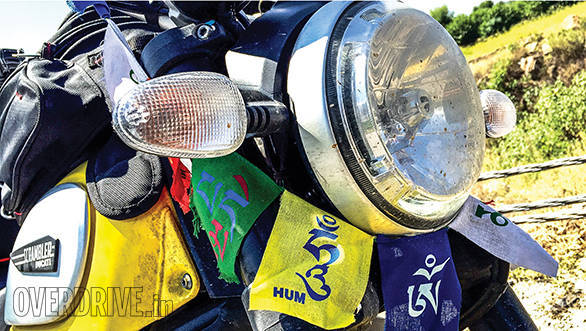
There is also the seat. I like that the Scrambler's seat and tank form a single unit. So when you want to shift all your weight forward, to gain front end traction, it is easy to slide yourself forward. The Bonnie, on the other hand, has a rather large tank which, while not overly cumbersome, isn't designed for this. But this isn't a huge problem, because you're not going to be trying to set speed records on the Triumph anyway. You're going to be too busy enjoying the ride and scenery for that.
Where the Bonnie clearly scores over the Scrambler, though, is when it comes to refinement. The Scrambler feels exactly like a Ducati L-twin. It is very unhappy being ridden around at low speeds and if you're in the wrong gear, it protests very violently. While the motor itself is a huge improvement over the Monster 796 motor it is based on (it has been tuned to shift the powerband to lower RPM), it still remains a pain in the backside in city traffic. But the Bonnie makes full use of the parallel-twin layout, extra displacement and lesser power output to deliver a super refined engine. The motor never feels stressed and on the racetrack-like roads between Kargil and Drass, the Bonnie felt like it could sit in high gears all day and pull from low speeds without any drama at all. It is very well-behaved and an occasional wrong gear at slow speeds will go unpunished. So, the problem the Ducati faces is that when there is an absolute lack of drama, even a little drama seems like a lot. And for most riders, the Bonnie will be the ideal choice.
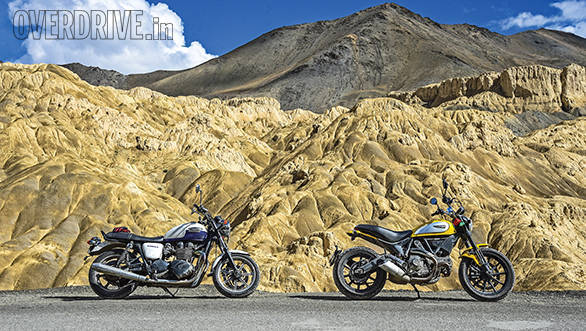
However, the Bonnie's engine does have a small chink in its refined armour. As we climbed to higher altitudes, the Scrambler remained completely unfazed and didn't seem to lose any performance at all. The Bonnie though started showing some signs of AMS. It wouldn't start at first crank like the Scrambler would every single time and it showed just a tiny bit of drop in performance.
Whatever small flaws that each motorcycle had, they both performed almost flawlessly over the entire span of 3,000km that we rode them. What was critical for us was that neither motorcycle broke down or had any significant loss in performance. This means that if you were to take either motorcycle up into the mountains, you are highly unlikely to face any problems unless you toss it. But then if you do toss it in this region, you will have more to worry about than a bent handlebar. Your life, for example. Anyway, as I sit staring at the snow covered peaks and listening to the river flowing for the last time on our return leg, one thing is clear. If I were to do this trip again, it would be the Ducati Scrambler that I choose to do it with. But this choice has more to do with the kind of rider that I am and the kind of motorcycle I appreciate. If you look at them objectively, they are both immensely capable motorcycles.
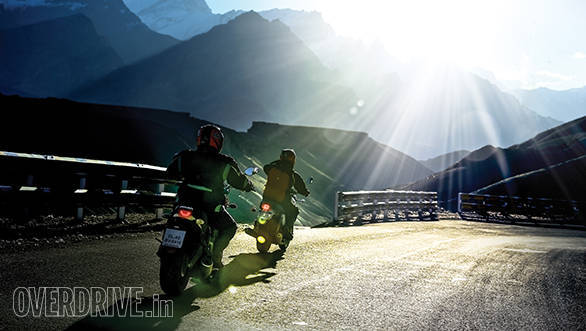 The fantastic scenery that you get to see in the Himalayas can take your breath away. Or it might just be AMS
The fantastic scenery that you get to see in the Himalayas can take your breath away. Or it might just be AMS
The Bonneville is a more mature motorcycle that will suit a more mature rider who would like to travel and take in the sights and sounds along the way. It is the kind of motorcycle that you keep for a lifetime, something that is evident from the fact that you almost never find a Bonnie in the second hand market. The Scrambler, then, is a more frantic ride. It likes being treated with a rough hand and, like me, younger, more aggressive riders will appreciate this temperament more. But there are two problems with the Scrambler that you can't overlook. One is that it is close to `80,000 more than the Bonneville. The second is that service and spares are anecdotally at least twice as much as the Triumph. For most people, these will be critical factors in their purchasing decision. For me though, the Scrambler holds more appeal. I like the fact that it likes being treated like a dirt bike and that you need to be a slightly more advanced rider to get the most out of this bike. For me, the Scrambler is a more rewarding experience.
Rohit and Rishaad's take on the Bonnieville
 Rohit Paradkar: With those low-set exhausts and not so generous ground clearance, I was skeptical at first about the Bonneville's ability to be able to tackle the likes of the Zoji La pass. But she handled it like a breeze. But what impressed me the most was the laidback nature of the engine. I like power but the laidback attitude of the Bonnie is just what this trip demanded. The seat was comfortable for this journey and the ride quality was pretty good once the luggage went into the support car. The lack of any aids gave it that old world charm and I think that is what made me connect with the bike better. To the extent that I want to own one.
Rishaad Mody: The Bonneville is among the first of the old school. It may be a turn off at first, but its sheer simplicity is what makes this such a beautiful motorcycle. I love the flexible and smooth engine you can run it in top gear all day long. The Bonnie blends comfort and ability beautifully. It's a great motorcycle to tour on because of the plush seat and supple suspension and it's not the kind of bike you want to go flat out on, so wind protection isn't much of a concern. It handles bad roads impressively and even on the worst stretches of Ladakh, I had no doubts that the bike would make it. Most of all though, I love the way it transports me back in time while still accelerating, turning and stopping like a modern machine. This bike will be in my garage some years down the road.
Rohit Paradkar: With those low-set exhausts and not so generous ground clearance, I was skeptical at first about the Bonneville's ability to be able to tackle the likes of the Zoji La pass. But she handled it like a breeze. But what impressed me the most was the laidback nature of the engine. I like power but the laidback attitude of the Bonnie is just what this trip demanded. The seat was comfortable for this journey and the ride quality was pretty good once the luggage went into the support car. The lack of any aids gave it that old world charm and I think that is what made me connect with the bike better. To the extent that I want to own one.
Rishaad Mody: The Bonneville is among the first of the old school. It may be a turn off at first, but its sheer simplicity is what makes this such a beautiful motorcycle. I love the flexible and smooth engine you can run it in top gear all day long. The Bonnie blends comfort and ability beautifully. It's a great motorcycle to tour on because of the plush seat and supple suspension and it's not the kind of bike you want to go flat out on, so wind protection isn't much of a concern. It handles bad roads impressively and even on the worst stretches of Ladakh, I had no doubts that the bike would make it. Most of all though, I love the way it transports me back in time while still accelerating, turning and stopping like a modern machine. This bike will be in my garage some years down the road. | |
Starts Rs 12,15,800
900cc
5-Speed
65.00
80.00
25.64 Kmpl
Starts Rs 7,99,000
803cc
6-Speed
73.00
67.00
-NA-
